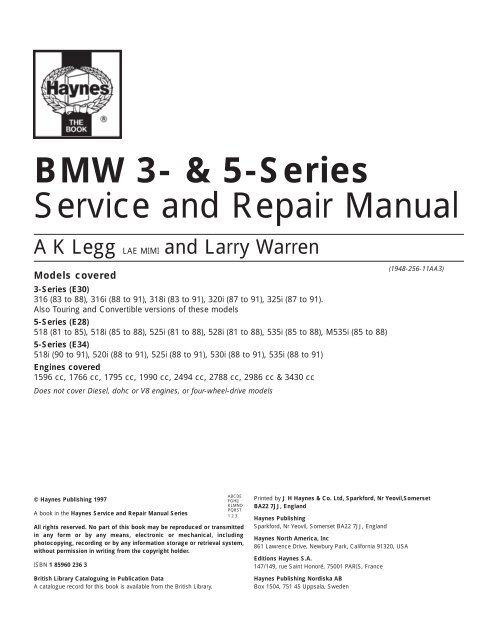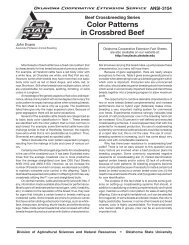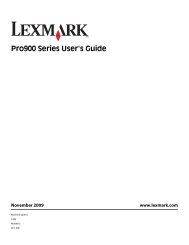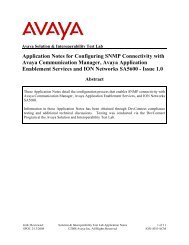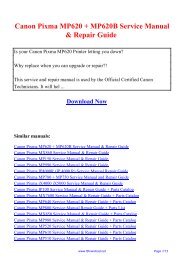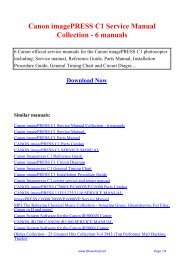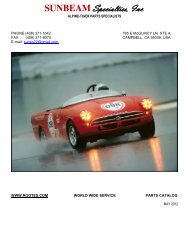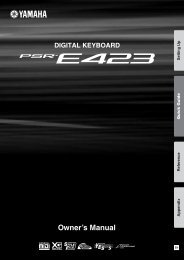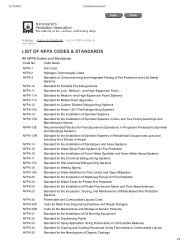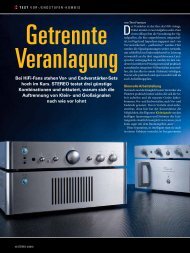BMW 3- & 5-Series Service and Repair Manual
BMW 3- & 5-Series Service and Repair Manual
BMW 3- & 5-Series Service and Repair Manual
Create successful ePaper yourself
Turn your PDF publications into a flip-book with our unique Google optimized e-Paper software.
<strong>BMW</strong> 3- & 5-<strong>Series</strong><br />
<strong>Service</strong> <strong>and</strong> <strong>Repair</strong> <strong>Manual</strong><br />
A K Legg LAE MIMI <strong>and</strong> Larry Warren<br />
Models covered<br />
3-<strong>Series</strong> (E30)<br />
316 (83 to 88), 316i (88 to 91), 318i (83 to 91), 320i (87 to 91), 325i (87 to 91).<br />
Also Touring <strong>and</strong> Convertible versions of these models<br />
5-<strong>Series</strong> (E28)<br />
518 (81 to 85), 518i (85 to 88), 525i (81 to 88), 528i (81 to 88), 535i (85 to 88), M535i (85 to 88)<br />
5-<strong>Series</strong> (E34)<br />
518i (90 to 91), 520i (88 to 91), 525i (88 to 91), 530i (88 to 91), 535i (88 to 91)<br />
Engines covered<br />
1596 cc, 1766 cc, 1795 cc, 1990 cc, 2494 cc, 2788 cc, 2986 cc & 3430 cc<br />
Does not cover Diesel, dohc or V8 engines, or four-wheel-drive models<br />
ABCDE<br />
© Haynes Publishing 1997<br />
FGHIJ<br />
KLMNO<br />
PQRST<br />
A book in the Haynes <strong>Service</strong> <strong>and</strong> <strong>Repair</strong> <strong>Manual</strong> <strong>Series</strong><br />
1 2 3<br />
All rights reserved. No part of this book may be reproduced or transmitted<br />
in any form or by any means, electronic or mechanical, including<br />
photocopying, recording or by any information storage or retrieval system,<br />
without permission in writing from the copyright holder.<br />
ISBN 1 85960 236 3<br />
British Library Cataloguing in Publication Data<br />
A catalogue record for this book is available from the British Library.<br />
Printed by J H Haynes & Co. Ltd, Sparkford, Nr Yeovil,Somerset<br />
BA22 7JJ, Engl<strong>and</strong><br />
Haynes Publishing<br />
Sparkford, Nr Yeovil, Somerset BA22 7JJ, Engl<strong>and</strong><br />
Haynes North America, Inc<br />
861 Lawrence Drive, Newbury Park, California 91320, USA<br />
Editions Haynes S.A.<br />
147/149, rue Saint Honoré, 75001 PARIS, France<br />
Haynes Publishing Nordiska AB<br />
Box 1504, 751 45 Uppsala, Sweden<br />
(1948-256-11AA3)
Contents<br />
LIVING WITH YOUR <strong>BMW</strong><br />
Introduction Page 0•4<br />
Safety First! Page 0•6<br />
Anti-theft audio system Page 0•7<br />
Instrument panel language display Page 0•7<br />
Roadside <strong>Repair</strong>s<br />
Jacking, towing <strong>and</strong> wheel changing Page 0•8<br />
Jump starting Page 0•9<br />
Identifying leaks Page 0•10<br />
ROUTINE MAINTENANCE<br />
Routine Maintenance <strong>and</strong> Servicing Page 1•1<br />
Lubricants <strong>and</strong> fluids Page 1•3<br />
Maintenance schedule Page 1•4<br />
Weekly checks Page 1•7<br />
Every 6000 miles Page 1•11<br />
Every 12 000 miles Page 1•16<br />
Every 24 000 miles Page 1•23<br />
Every 60 000 miles Page 1•26
REPAIRS & OVERHAUL<br />
Engine <strong>and</strong> Associated Systems<br />
In-car engine repair procedures Page 2A•1<br />
General engine overhaul procedures Page 2B•1<br />
Cooling, heating <strong>and</strong> air conditioning systems Page 3•1<br />
Fuel <strong>and</strong> exhaust systems Page 4•1<br />
Engine electrical systems Page 5•1<br />
Engine management <strong>and</strong> emission control systems Page 6•1<br />
Transmission<br />
<strong>Manual</strong> transmission Page 7A•1<br />
Automatic transmission Page 7B•1<br />
Clutch <strong>and</strong> driveline Page 8•1<br />
Brakes<br />
Braking system Page 9•1<br />
Suspension<br />
Suspension <strong>and</strong> steering systems Page 10•1<br />
Body Equipment<br />
Bodywork <strong>and</strong> fittings Page 11•1<br />
Electrical<br />
Body electrical systems Page 12•1<br />
Wiring Diagrams Page 12•10<br />
REFERENCE<br />
MOT Test Checks<br />
Contents<br />
Checks carried out from the driver’s seat Page REF•1<br />
Checks carried out with the vehicle on the ground Page REF•2<br />
Checks carried out with the vehicle raised Page REF•3<br />
Checks carried out on your vehicle’s exhaust emission system Page REF•4<br />
Tools <strong>and</strong> Working Facilities Page REF•5<br />
General <strong>Repair</strong> Procedures Page REF•8<br />
Fault Finding Page REF•9<br />
Conversion factors Page REF•17<br />
Automotive chemicals <strong>and</strong> lubricants Page REF•18<br />
Buying spare parts <strong>and</strong> vehicle identification numbers Page REF•19<br />
Glossary of Technical Terms Page REF•20<br />
Index Page REF•25
0•4 Introduction<br />
Introduction to the <strong>BMW</strong> 3- <strong>and</strong> 5-<strong>Series</strong><br />
The E30 3-<strong>Series</strong> range first became<br />
available in the UK in March 1983, <strong>and</strong><br />
continued in production until April 1991, when<br />
the revised E36 3-<strong>Series</strong> range (not covered<br />
by this manual) was introduced. Convertible<br />
<strong>and</strong> Touring (Estate) models were introduced<br />
for 1988, <strong>and</strong> these models have continued in<br />
E30 form to date.<br />
The E28 5-<strong>Series</strong> models were introduced<br />
in October 1981, <strong>and</strong> were superseded in<br />
June 1988 by the revised E34 5-<strong>Series</strong> range,<br />
Touring versions of which became available<br />
from March 1992. Throughout this manual,<br />
E28 models are also referred to as “oldshape”,<br />
while E34 models are designated<br />
“new-shape”.<br />
The models covered by this manual are<br />
equipped with single overhead cam in-line<br />
four- <strong>and</strong> six-cylinder engines. Early 316 <strong>and</strong><br />
518 models are fitted with carburettors, but all<br />
other models are fitted with fuel injection<br />
systems. Transmissions are a five-speed<br />
manual, or three- or four-speed automatic.<br />
The transmission is mounted to the back of<br />
the engine, <strong>and</strong> power is transmitted to the<br />
fully-independent rear axle through a twopiece<br />
propeller shaft. The final drive unit is<br />
bolted solidly to a frame crossmember, <strong>and</strong><br />
drives the rear wheels through driveshafts<br />
equipped with inner <strong>and</strong> outer constant<br />
velocity joints.<br />
The front suspension is of MacPherson<br />
strut type, with the coil spring/shock absorber<br />
unit making up the upper suspension link. The<br />
rear suspension is made up of coil springover-shock<br />
absorber struts, or coil springs<br />
<strong>and</strong> conventional shock absorbers,<br />
depending on model.<br />
The brakes are disc type at the front, with<br />
either drums or discs at the rear, depending<br />
on model. Servo assistance is st<strong>and</strong>ard on all<br />
models. Some later models are equipped with<br />
an Anti-lock Braking System (ABS).<br />
All models are manufactured to fine limits,<br />
<strong>and</strong> live up to the <strong>BMW</strong> reputation of quality<br />
workmanship. Although many of the models<br />
covered by this manual appear complex at<br />
first sight, they should present no problems to<br />
the home mechanic.<br />
Note for UK readers<br />
The greater part of this manual was<br />
originally written in the USA. Some of the<br />
photographs used are of American-market<br />
models, but the procedures given are fully<br />
applicable to right-h<strong>and</strong>-drive models (or have<br />
been amended where necessary).<br />
<strong>BMW</strong> 320i Saloon (E30)<br />
Acknowledgements<br />
Thanks are due to Champion Spark Plug,<br />
who supplied the illustrations showing spark<br />
plug conditions. Thanks are also due to<br />
Sykes-Pickavant Limited, who provided some<br />
of the workshop tools, <strong>and</strong> to all those people<br />
at Sparkford who helped in the production of<br />
this manual. Technical writers who<br />
contributed to this project include Robert<br />
Maddox, Mark Ryan <strong>and</strong> Mike Stubblefield.<br />
We take great pride in the accuracy of<br />
information given in this manual, but<br />
vehicle manufacturers make alterations<br />
<strong>and</strong> design changes during the production<br />
run of a particular vehicle of which they do<br />
not inform us. No liability can be accepted<br />
by the authors or publishers for loss,<br />
damage or injury caused by any<br />
errors in, or omissions from, the<br />
information given.<br />
Project vehicles<br />
The main project vehicle used in the<br />
preparation of this manual for the UK market<br />
was a 1988 <strong>BMW</strong> 318i with an M40/B18<br />
engine.
<strong>BMW</strong> 325i Touring (E30)<br />
<strong>BMW</strong> 518i (E28)<br />
<strong>BMW</strong> 325i Convertible (E30)<br />
<strong>BMW</strong> 535i (E34)<br />
Introduction<br />
0•5
0•6 Safety First!<br />
Working on your car can be dangerous.<br />
This page shows just some of the potential<br />
risks <strong>and</strong> hazards, with the aim of creating a<br />
safety-conscious attitude.<br />
General hazards<br />
Scalding<br />
• Don’t remove the radiator or expansion<br />
tank cap while the engine is hot.<br />
• Engine oil, automatic transmission fluid or<br />
power steering fluid may also be dangerously<br />
hot if the engine has recently been running.<br />
Burning<br />
• Beware of burns from the exhaust system<br />
<strong>and</strong> from any part of the engine. Brake discs<br />
<strong>and</strong> drums can also be extremely hot<br />
immediately after use.<br />
Crushing<br />
• When working under or near<br />
a raised vehicle,<br />
always<br />
supplement the<br />
jack with axle<br />
st<strong>and</strong>s, or use<br />
drive-on<br />
ramps.<br />
Never<br />
venture<br />
under a car which<br />
is only supported by a jack.<br />
• Take care if loosening or tightening hightorque<br />
nuts when the vehicle is on st<strong>and</strong>s.<br />
Initial loosening <strong>and</strong> final tightening should<br />
be done with the wheels on the ground.<br />
Fire<br />
• Fuel is highly flammable; fuel vapour is<br />
explosive.<br />
• Don’t let fuel spill onto a hot engine.<br />
• Do not smoke or allow naked lights<br />
(including pilot lights) anywhere near a<br />
vehicle being worked on. Also beware of<br />
creating sparks<br />
(electrically or by use of tools).<br />
• Fuel vapour is heavier than air, so don’t<br />
work on the fuel system with the vehicle over<br />
an inspection pit.<br />
• Another cause of fire is an electrical<br />
overload or short-circuit. Take care when<br />
repairing or modifying the vehicle wiring.<br />
• Keep a fire extinguisher h<strong>and</strong>y, of a type<br />
suitable for use on fuel <strong>and</strong> electrical fires.<br />
Electric shock<br />
• Ignition HT<br />
voltage can be<br />
dangerous,<br />
especially to<br />
people with heart<br />
problems or a<br />
pacemaker. Don’t<br />
work on or near the<br />
ignition system with<br />
the engine running or<br />
the ignition switched on.<br />
• Mains voltage is also dangerous. Make<br />
sure that any mains-operated equipment is<br />
correctly earthed. Mains power points should<br />
be protected by a residual current device<br />
(RCD) circuit breaker.<br />
Fume or gas intoxication<br />
• Exhaust fumes are<br />
poisonous; they often<br />
contain carbon<br />
monoxide, which is<br />
rapidly fatal if inhaled.<br />
Never run the<br />
engine in a<br />
confined space<br />
such as a garage<br />
with the doors shut.<br />
• Fuel vapour is also<br />
poisonous, as are the vapours from some<br />
cleaning solvents <strong>and</strong> paint thinners.<br />
Poisonous or irritant substances<br />
• Avoid skin contact with battery acid <strong>and</strong><br />
with any fuel, fluid or lubricant, especially<br />
antifreeze, brake hydraulic fluid <strong>and</strong> Diesel<br />
fuel. Don’t syphon them by mouth. If such a<br />
substance is swallowed or gets into the eyes,<br />
seek medical advice.<br />
• Prolonged contact with used engine oil can<br />
cause skin cancer. Wear gloves or use a<br />
barrier cream if necessary. Change out of oilsoaked<br />
clothes <strong>and</strong> do not keep oily rags in<br />
your pocket.<br />
• Air conditioning refrigerant forms a<br />
poisonous gas if exposed to a naked flame<br />
(including a cigarette). It can also cause skin<br />
burns on contact.<br />
Asbestos<br />
• Asbestos dust can cause cancer if inhaled<br />
or swallowed. Asbestos may be found in<br />
gaskets <strong>and</strong> in brake <strong>and</strong> clutch linings.<br />
When dealing with such components it is<br />
safest to assume that they contain asbestos.<br />
Remember...<br />
DO<br />
• Do use eye protection when using power<br />
tools, <strong>and</strong> when working under the vehicle.<br />
• Do wear gloves or use barrier cream to<br />
protect your h<strong>and</strong>s when necessary.<br />
• Do get someone to check periodically<br />
that all is well when working alone on the<br />
vehicle.<br />
• Do keep loose clothing <strong>and</strong> long hair well<br />
out of the way of moving mechanical parts.<br />
• Do remove rings, wristwatch etc, before<br />
working on the vehicle – especially the<br />
electrical system.<br />
• Do ensure that any lifting or jacking<br />
equipment has a safe working load rating<br />
adequate for the job.<br />
Special hazards<br />
Hydrofluoric acid<br />
• This extremely corrosive acid is formed<br />
when certain types of synthetic rubber, found<br />
in some O-rings, oil seals, fuel hoses etc, are<br />
exposed to temperatures above 4000C. The<br />
rubber changes into a charred or sticky<br />
substance containing the acid. Once formed,<br />
the acid remains dangerous for years. If it<br />
gets onto the skin, it may be necessary to<br />
amputate the limb concerned.<br />
• When dealing with a vehicle which has<br />
suffered a fire, or with components salvaged<br />
from such a vehicle, wear protective gloves<br />
<strong>and</strong> discard them after use.<br />
The battery<br />
• Batteries contain sulphuric acid, which<br />
attacks clothing, eyes <strong>and</strong> skin. Take care<br />
when topping-up or carrying the battery.<br />
• The hydrogen gas given off by the battery<br />
is highly explosive. Never cause a spark or<br />
allow a naked light nearby. Be careful when<br />
connecting <strong>and</strong> disconnecting battery<br />
chargers or jump leads.<br />
Air bags<br />
• Air bags can cause injury if they go off<br />
accidentally. Take care when removing the<br />
steering wheel <strong>and</strong>/or facia. Special storage<br />
instructions may apply.<br />
Diesel injection equipment<br />
• Diesel injection pumps supply fuel at very<br />
high pressure. Take care when working on<br />
the fuel injectors <strong>and</strong> fuel pipes.<br />
Warning: Never expose the h<strong>and</strong>s,<br />
face or any other part of the body<br />
to injector spray; the fuel can<br />
penetrate the skin with potentially fatal<br />
results.<br />
A few tips<br />
DON’T<br />
• Don’t attempt to lift a heavy component<br />
which may be beyond your capability – get<br />
assistance.<br />
• Don’t rush to finish a job, or take<br />
unverified short cuts.<br />
• Don’t use ill-fitting tools which may slip<br />
<strong>and</strong> cause injury.<br />
• Don’t leave tools or parts lying around<br />
where someone can trip over them. Mop<br />
up oil <strong>and</strong> fuel spills at once.<br />
• Don’t allow children or pets to play in or<br />
near a vehicle being worked on.
Anti-theft audio system<br />
General information<br />
Some models are equipped with an audio<br />
system having an anti-theft feature that will<br />
render the stereo inoperative if stolen. If the<br />
power source to the stereo is cut, the stereo<br />
won’t work even if the power source is<br />
immediately re-connected. If your vehicle is<br />
equipped with this anti-theft system, do not<br />
disconnect the battery or remove the stereo<br />
unless you have the individual code number<br />
for the stereo.<br />
Refer to the owner’s h<strong>and</strong>book supplied<br />
with the vehicle for more complete<br />
information on this audio system <strong>and</strong> its antitheft<br />
feature.<br />
Unlocking procedure<br />
1 Turn on the radio. The word “CODE” should<br />
appear on the display.<br />
2 Using the station preset selector buttons,<br />
enter the five-digit code. If you make a<br />
mistake when entering the code, continue<br />
the five-digit sequence anyway. If you hear<br />
a “beep,” however, stop immediately <strong>and</strong><br />
Instrument panel language display<br />
On some later models, disconnecting the<br />
battery may cause the instrument panel<br />
display to default to the German language<br />
(this does not usually apply to UK models). If<br />
it is necessary to reset the correct language<br />
after the battery is reconnected, proceed as<br />
follows. With all the doors shut <strong>and</strong> the<br />
ignition on (engine not running), press the trip<br />
reset button until the panel displays the<br />
desired language. There are eight languages<br />
available. If you wish to bypass a particular<br />
selection, release the reset button <strong>and</strong> press<br />
again - this will cause the display to advance<br />
to the next language. Once the correct<br />
Anti-theft audio system<br />
0•7<br />
start the sequence over again. Note: You<br />
have three attempts to enter the correct<br />
code. If the correct code isn’t entered in<br />
three tries, you’ll have to wait one hour, with<br />
the radio on, before you enter the codes<br />
again.<br />
5 Once the code has been entered correctly,<br />
the word “CODE” should disappear from the<br />
display, <strong>and</strong> the radio should play (you’ll have<br />
to tune-in <strong>and</strong> enter your preset stations,<br />
however).<br />
6 If you have lost your code number, contact<br />
a <strong>BMW</strong> dealer service department.<br />
language has been selected, continue holding<br />
the reset button until the display reads “I.O.<br />
Version 2.0”. Continue holding the button until<br />
it reads “H.P. Version 3.4”, then release the<br />
button.
0•8<br />
Roadside <strong>Repair</strong>s<br />
Jacking, towing <strong>and</strong> wheel changing<br />
Jacking <strong>and</strong> wheel<br />
changing<br />
The jack supplied with the vehicle should<br />
be used only for raising the vehicle when<br />
changing a tyre or placing axle st<strong>and</strong>s under<br />
the frame.<br />
Warning: Never crawl under the<br />
vehicle or start the engine when<br />
this jack is being used as the<br />
only means of support.<br />
When changing a wheel, the vehicle should<br />
be on level ground, with the h<strong>and</strong>brake firmly<br />
applied, <strong>and</strong> the wheels chocked. Select<br />
reverse gear (manual transmission) or Park<br />
(automatic transmission). Prise off the hub<br />
cap (if equipped) using the tapered end of the<br />
wheel brace. Loosen the wheel bolts half a<br />
turn, leaving them in place until the wheel is<br />
raised off the ground.<br />
Position the head of the jack under the side<br />
of the vehicle, making sure it engages with the<br />
pocket made for this purpose (just behind the<br />
front wheel, or forward of the rear wheel).<br />
Engage the wheel brace h<strong>and</strong>le <strong>and</strong> turn it<br />
clockwise until the wheel is raised off the<br />
ground. Unscrew the bolts, remove the wheel<br />
<strong>and</strong> fit the spare.<br />
Refit the wheel bolts <strong>and</strong> tighten them<br />
finger-tight. Lower the vehicle by turning the<br />
wheel brace anti-clockwise. Remove the jack<br />
<strong>and</strong> tighten the bolts in a diagonal pattern to<br />
the torque listed in the Chapter 1<br />
Specifications. If a torque wrench is not<br />
available, have the torque checked by a <strong>BMW</strong><br />
dealer or tyre fitting specialist as soon as<br />
possible. Refit the hubcap.<br />
Towing<br />
Vehicles with manual transmission can be<br />
towed with all four wheels on the ground, if<br />
necessary. Automatic transmission-equipped<br />
vehicles can only be towed with all four<br />
wheels on the ground providing that the<br />
speed does not exceed 35 mph <strong>and</strong> the<br />
distance is not over 50 miles, otherwise<br />
transmission damage can result. For<br />
preference, regardless of transmission type,<br />
the vehicle should be towed with the driven<br />
(rear) wheels off the ground.<br />
Proper towing equipment, specifically<br />
designed for the purpose, should be used,<br />
<strong>and</strong> should be attached to the main structural<br />
members of the vehicle, not to the bumpers or<br />
bumper brackets. Sling-type towing<br />
equipment must not be used on these<br />
vehicles.<br />
Safety is a major consideration while<br />
towing. The h<strong>and</strong>brake should be released,<br />
<strong>and</strong> the transmission should be in neutral. The<br />
steering must be unlocked (ignition switch<br />
turned to position “1”). Remember that<br />
power-assisted steering (where fitted) <strong>and</strong> the<br />
brake servo will not work with the engine<br />
switched off.
Jump starting will get you out<br />
of trouble, but you must correct<br />
whatever made the battery go<br />
flat in the first place. There are<br />
three possibilities:<br />
1The battery has been drained by<br />
repeated attempts to start, or by<br />
leaving the lights on.<br />
2 The<br />
charging system is not working<br />
properly (alternator drivebelt slack<br />
or broken, alternator wiring fault or<br />
alternator itself faulty).<br />
3 The<br />
battery itself is at fault<br />
(electrolyte low, or battery worn out).<br />
When jump-starting a car using a<br />
booster battery, observe the following<br />
precautions:<br />
4 Before connecting the booster<br />
battery, make sure that the ignition is<br />
switched off.<br />
4 Ensure that all electrical equipment<br />
(lights, heater, wipers, etc) is<br />
switched off.<br />
1 2 3<br />
Connect one end of the red jump lead to<br />
the positive (+) terminal of the flat<br />
battery<br />
Connect the other end of the red lead to<br />
the positive (+) terminal of the booster<br />
battery.<br />
Roadside <strong>Repair</strong>s<br />
0•9<br />
4 Make sure that the booster battery is<br />
the same voltage as the discharged<br />
one in the vehicle.<br />
4 If the battery is being jump-started<br />
from the battery in another vehicle,<br />
the two vehcles MUST NOT TOUCH<br />
each other.<br />
4 Make sure that the transmission is in<br />
neutral (or PARK, in the case of<br />
automatic transmission).<br />
4<br />
5<br />
6<br />
Jump starting<br />
Connect one end of the black jump lead<br />
to the negative (-) terminal of the<br />
booster battery<br />
Connect the other end of the black<br />
jump lead to a bolt or bracket on the<br />
engine block, well away from the<br />
battery, on the vehicle to be started.<br />
Make sure that the jump leads will not<br />
come into contact with the fan, drivebelts<br />
or other moving parts of the<br />
engine.<br />
Start the engine using the booster<br />
battery, then with the engine running at<br />
idle speed, disconnect the jump leads in<br />
the reverse order of connection.
0•10 Roadside <strong>Repair</strong>s<br />
Identifying leaks<br />
Puddles on the garage floor or drive, or<br />
obvious wetness under the bonnet or<br />
underneath the car, suggest a leak that needs<br />
investigating. It can sometimes be difficult to<br />
decide where the leak is coming from,<br />
especially if the engine bay is very dirty<br />
already. Leaking oil or fluid can also be blown<br />
rearwards by the passage of air under the car,<br />
giving a false impression of where the<br />
problem lies.<br />
Warning: Most automotive oils<br />
<strong>and</strong> fluids are poisonous. Wash<br />
them off skin, <strong>and</strong> change out of<br />
contaminated clothing, without<br />
delay.<br />
The smell of a fluid leaking<br />
from the car may provide a<br />
clue to what’s leaking. Some<br />
fluids are distinctively<br />
coloured. It may help to clean the car<br />
carefully <strong>and</strong> to park it over some clean<br />
paper overnight as an aid to locating the<br />
source of the leak.<br />
Remember that some leaks may only<br />
occur while the engine is running.<br />
Sump oil Oil from filter<br />
Gearbox oil<br />
Engine oil may leak from the drain plug... ...or from the base of the oil filter.<br />
Antifreeze<br />
Leaking antifreeze often leaves a crystalline<br />
deposit like this.<br />
Gearbox oil can leak from the seals at the<br />
inboard ends of the driveshafts.<br />
Brake fluid Power steering fluid<br />
A leak occurring at a wheel is almost<br />
certainly brake fluid.<br />
Power steering fluid may leak from the pipe<br />
connectors on the steering rack.


